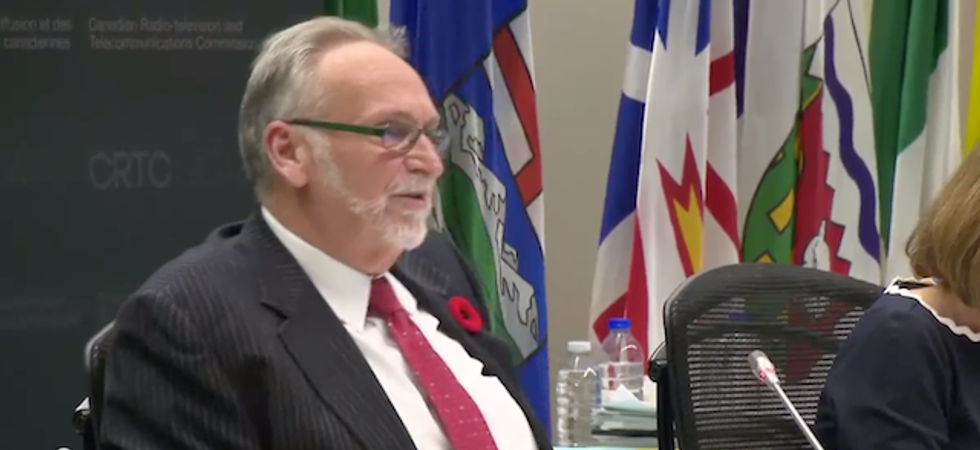CRTC Chair Ian Scott Spells Out the Future
CRTC Chair Ian Scott Spells Out The Future
The following was said by CRTC Chair Ian Scott to the Senate Standing Committee on Transport and Communications yesterday.

By External Source
CRTC Chair Ian Scott Spells Out The Future
The following was said by CRTC Chair Ian Scott to the Senate Standing Committee on Transport and Communications yesterday.
Mister Chairman and Honourable Senators,
My name is Ian Scott. I am the Chairperson of the Canadian Radio-television and Telecommunications Commission. With me today are the CRTC’s Executive Directors of Broadcasting and Telecommunications, Scott Hutton and Chris Seidl, and our Senior Legal Counsel Rachelle Frenette. Thank you for inviting us to provide input into your study on the modernization of Canadian communications legislation.
As the entity that regulates and supervises the broadcasting and telecommunications industries, the CRTC is dedicated to ensuring that Canadians have access to a world-class communications system that promotes innovation and enriches their lives. We therefore have a deep interest in your study.
Before beginning, I should remind the committee that the CRTC is an administrative tribunal that operates at arm’s length from the federal government. We are unable to comment on any open proceedings before our Commission or before the court. Unlike Parliamentarians who enjoy the privilege of creating legislation, and departments that set policies, the CRTC is a regulatory body. Our role is to implement the laws and regulations set by those bodies.
Situations and challenges
Your study is timely. Communications have never been in a greater state of flux. Broadband Internet has changed, is changing, and will continue to change the ways in which Canadians communicate with themselves, their government and the institutions around them.
More and more, people are consuming media and connecting with their peers across digital channels. They are turning less to traditional devices to communicate, learn and discover. Legislation has to not only keep up with current challenges, but also be flexible enough to accommodate future needs.
Let me outline some of the challenges that we will face in the broadcasting and telecommunications sectors over the next few years.
In broadcasting, our main challenge is to encourage the production and promotion of Canadian programming in the face of technological change. Canadian content benefits all Canadians. It promotes Canadian identity and culture, and places creative industries at the centre of the economy. But the supports for this programming that we’ve had in place for the past 50 years are under pressure.
The current legislative and regulatory approach is focused almost exclusively on traditional television and radio services. And it is becoming less effective. As consumption of these services declines, so does revenue. The production of high-quality content will suffer as a result.
We examined the future of programming distribution in Canada in our Harnessing Change report. Prepared at the request of government and released in May of this year, this report asked one fundamental question: What can be done to support the production, discoverability and promotion of Canadian programming? Harnessing Change concludes that new innovative approaches that would engage digital players are needed.
Let me outline the three principles that we think should guide us in the future.
The first is that future policy approaches should not only focus on the production and promotion of high-quality content made by Canadians, but also on the discoverability of those programs. It’s not enough to make great content. That content has to be found to be enjoyed.
The second is that all players that benefit from participating in the Canadian broadcasting system should contribute to it in an appropriate and equitable manner. It’s no longer enough for new players to draw significant revenues from the system without giving back to it. There are social and cultural responsibilities that come with operating in Canada.
And the third is that future legislation and regulation must be nimble and innovative. It must easily adapt to changes in consumer demand and technology. The tools we develop for the future must assume that unforeseen changes will be the norm and must be flexible enough to continuously adapt along with them.
On the telecommunications side, a key challenge is access to comparable broadband Internet services for all Canadians. This technology is vital to Canadians and businesses. But as it stands, many outside major urban centres struggle to access the same speeds, data offerings and quality of service as those in urban areas.
In 2016, we established a universal service objective that Canadians have access to voice services and broadband Internet access services on fixed and mobile wireless networks. We remain committed to our objective of all Canadians being able to access fixed broadband Internet services with download speeds of at least 50 megabits per second and upload speeds of at least 10 megabits per second. We anticipate that 90% of Canadians will have access to this level of service by 2021.
Another key challenge in telecommunications is the advent of fifth-generation, or 5G, wireless technology. Among other things, 5G networks will enable Internet of Things devices embedded in everyday objects, such as cars, household appliances, alarm systems and vending machines. These objects will be able to send and receive data, and provide new applications and services to consumers and businesses.
This new technology will transform our telecommunications environment, and will require significant network densification.
Today’s wireless infrastructure depends on towers, conduits and poles. In the 5G era, even more infrastructure will be required. Much more. Why? Because 5G operates at higher frequencies that cannot easily penetrate walls or buildings.
To maximize the benefits of this technology, small cells will need to be much closer to each other than current cell towers. Hundreds of thousands of small cells equipped with radio equipment and antennae, and which are the size of pizza boxes, will need to be installed onto infrastructure such as lampposts, newspaper boxes and bus shelters—as well as office buildings—throughout Canada over the next five to seven years to support this new technology.
To install these small cells, a number of issues—such as rights of way, poles and ducts—will need to be resolved. These are tricky issues that cut across provincial and municipal jurisdictions as well as private interests. The Government of Canada has already acknowledged that shared responsibility over this passive infrastructure presents challenges for the efficient deployment of 5G.
For our part, the CRTC has limited powers to intervene. We lack complete jurisdiction. Legislative changes that would allow the CRTC to resolve disputes, order access and establish guidelines with respect to all passive infrastructure may be a solution. This additional authority should also apply to non-traditional structures—the lampposts and bus shelters I mentioned a moment ago—since access to these structures will be critical for the efficient deployment of future technologies.
Honourable Senators, I cannot overstate the importance of fixed broadband Internet and 5G. This infrastructure could give Canada a competitive advantage. A robust telecommunications network will improve productivity and boost Canada’s economy.
The final challenge I’d like to bring forward is maintaining net neutrality. This has been a firm principle of the CRTC for more than a decade, but will likely be tested as needs and technology continue to evolve. My colleagues and I will be happy to discuss this important issue in detail during the question and answer period.
Flexible and adaptable legislative tools
So what is the recipe for success? How can legislation be made more adaptable and responsive to changing needs? What does the CRTC require to ensure a fair and equitable communications industry?
The answer—simply put—is new tools that are adaptable to enforce our regulatory policies—not only for today, but also for the future. They need to sit alongside the effective tools we already have, and be easy to use, flexible and efficient.
Conversely, more rigid tools will result in less efficient and effective regulation.
What tools are we looking for specifically?
I’ve mentioned already the certainty needed to address any disputes that arise regarding rights of way and the deployment of infrastructure to support future network deployment and technologies.
Another tool is administrative monetary penalties (AMPs) for the broadcasting sector. The Broadcasting Act, as it is currently written, does not allow the CRTC to impose AMPs when broadcasters do not respect their obligations. It’s true that we can revoke a broadcaster’s licence for non-compliance, or require them to appear before us. But what we lack is an easy-to-implement solution to bring broadcasters into compliance.
For example, if a television channel were to have consistent problems with their closed captioning or the loudness of the commercials they broadcast, the CRTC could launch a process to revoke their licence. While effective, that process takes time and costs taxpayer money. AMPs, on the other hand, could address non-compliance more quickly and efficiently.
We’ve seen how well AMPs work from an unsolicited communications perspective. The CRTC uses such tools to enforce the Unsolicited Telecommunications Rules, including the National Do Not Call List. They work and they incentivize compliance with the law.
Conclusion
Mister Chairman, Honourable Senators: the CRTC will regulate, supervise and enforce the legislation put before us.
However, given the pace at which communications technology is changing, a flexible and nimble toolkit will be critical to our future success. Simply put, there is a real danger in drafting legislation that is too prescriptive. We need the discretion to adapt.
The CRTC, like this Senate committee, works for the benefit of Canadians. We appreciate the government’s focus on the modernization of Canadian communications legislation, and we are here to explain the changes we believe we need to the Broadcasting and Telecommunications Acts.
We look forward to your questions.















